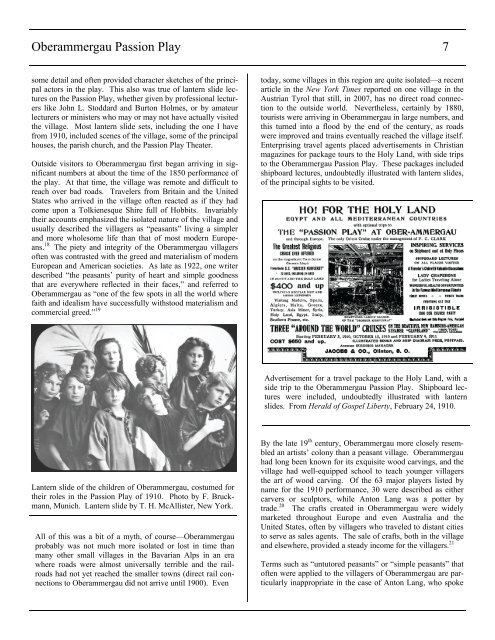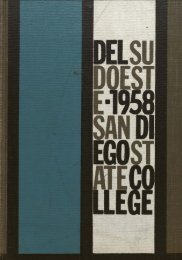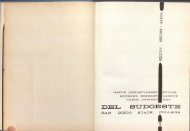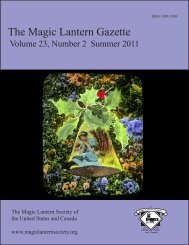The Magic Lantern Gazette - Library
The Magic Lantern Gazette - Library
The Magic Lantern Gazette - Library
You also want an ePaper? Increase the reach of your titles
YUMPU automatically turns print PDFs into web optimized ePapers that Google loves.
Oberammergau Passion Play 7<br />
some detail and often provided character sketches of the principal<br />
actors in the play. This also was true of lantern slide lectures<br />
on the Passion Play, whether given by professional lecturers<br />
like John L. Stoddard and Burton Holmes, or by amateur<br />
lecturers or ministers who may or may not have actually visited<br />
the village. Most lantern slide sets, including the one I have<br />
from 1910, included scenes of the village, some of the principal<br />
houses, the parish church, and the Passion Play <strong>The</strong>ater.<br />
Outside visitors to Oberammergau first began arriving in significant<br />
numbers at about the time of the 1850 performance of<br />
the play. At that time, the village was remote and difficult to<br />
reach over bad roads. Travelers from Britain and the United<br />
States who arrived in the village often reacted as if they had<br />
come upon a Tolkienesque Shire full of Hobbits. Invariably<br />
their accounts emphasized the isolated nature of the village and<br />
usually described the villagers as “peasants” living a simpler<br />
and more wholesome life than that of most modern Europeans.<br />
18 <strong>The</strong> piety and integrity of the Oberammergau villagers<br />
often was contrasted with the greed and materialism of modern<br />
European and American societies. As late as 1922, one writer<br />
described “the peasants’ purity of heart and simple goodness<br />
that are everywhere reflected in their faces,” and referred to<br />
Oberammergau as “one of the few spots in all the world where<br />
faith and idealism have successfully withstood materialism and<br />
commercial greed.” 19<br />
today, some villages in this region are quite isolated—a recent<br />
article in the New York Times reported on one village in the<br />
Austrian Tyrol that still, in 2007, has no direct road connection<br />
to the outside world. Nevertheless, certainly by 1880,<br />
tourists were arriving in Oberammergau in large numbers, and<br />
this turned into a flood by the end of the century, as roads<br />
were improved and trains eventually reached the village itself.<br />
Enterprising travel agents placed advertisements in Christian<br />
magazines for package tours to the Holy Land, with side trips<br />
to the Oberammergau Passion Play. <strong>The</strong>se packages included<br />
shipboard lectures, undoubtedly illustrated with lantern slides,<br />
of the principal sights to be visited.<br />
Advertisement for a travel package to the Holy Land, with a<br />
side trip to the Oberammergau Passion Play. Shipboard lectures<br />
were included, undoubtedly illustrated with lantern<br />
slides. From Herald of Gospel Liberty, February 24, 1910.<br />
<strong>Lantern</strong> slide of the children of Oberammergau, costumed for<br />
their roles in the Passion Play of 1910. Photo by F. Bruckmann,<br />
Munich. <strong>Lantern</strong> slide by T. H. McAllister, New York.<br />
All of this was a bit of a myth, of course—Oberammergau<br />
probably was not much more isolated or lost in time than<br />
many other small villages in the Bavarian Alps in an era<br />
where roads were almost universally terrible and the railroads<br />
had not yet reached the smaller towns (direct rail connections<br />
to Oberammergau did not arrive until 1900). Even<br />
By the late 19 th century, Oberammergau more closely resembled<br />
an artists’ colony than a peasant village. Oberammergau<br />
had long been known for its exquisite wood carvings, and the<br />
village had well-equipped school to teach younger villagers<br />
the art of wood carving. Of the 63 major players listed by<br />
name for the 1910 performance, 30 were described as either<br />
carvers or sculptors, while Anton Lang was a potter by<br />
trade. 20 <strong>The</strong> crafts created in Oberammergau were widely<br />
marketed throughout Europe and even Australia and the<br />
United States, often by villagers who traveled to distant cities<br />
to serve as sales agents. <strong>The</strong> sale of crafts, both in the village<br />
and elsewhere, provided a steady income for the villagers. 21<br />
Terms such as “untutored peasants” or “simple peasants” that<br />
often were applied to the villagers of Oberammergau are particularly<br />
inappropriate in the case of Anton Lang, who spoke
















